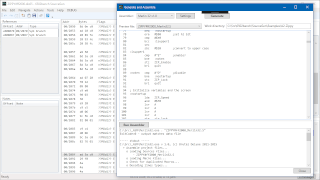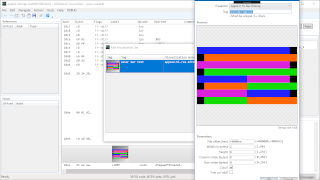6502bench is a code development "workbench" for the 65xx family of processors, including the 6502, 65C02, and 65802/65816. It currently features one tool, the SourceGen disassembler.
SourceGen is an industrial-strength disassembler for 6502, 65C02, and 65816 programs. It runs on Windows 7 or later.
Demos and information:
- Watch a 9-minute product introduction video (from v1.0).
- See an 8-minute demonstration of visualizers in a disassembly of the Apple II game Space Eggs.
- SourceGen has been used to disassemble software for the Apple II, NES (Nintendo Entertainment System), Atari 2600 VCS, and coin-op arcade systems. Visit 6502disassembly.com to see examples of completed disassembly projects.
Check out the GitHub project, where you can download source & binaries for the latest version from the Releases page.
Key features include:
- Fully interactive point-and-click GUI. Define labels, set addresses, add comments, and see the results immediately. Add multi-line comments and have them word-wrapped automatically. Create inline visualizations of embedded bitmaps and wireframe data, and define animated sequences.
- Sophisticated static analysis. The disassembly engine traces code execution, automatically finding all instructions reachable from a given starting point. Changes to the processor status flags are tracked, allowing identification of branches that are always/never taken, accurate cycle count listings, and easier analysis of 65816 code with variable-width registers.
- Easy generation of assembly source code in popular formats (currently 64tass, ACME, cc65, and Merlin 32). Cross-assemblers can be invoked from the GUI to verify correctness.
- Symbols and constants are provided for ROM and operating system entry points on several popular systems (Apple, Atari, Commodore, others).
- Project files are designed for sharing and collaboration.
Features in Detail:
- Analyzer:
- Support for 6502, 65C02, and 65816, including undocumented opcodes and the W65C02 extensions.
- Code tagging mechanism allows manual identification of code start/stop points and inline data.
- Editable labels are generated for every branch destination and data target.
- Automatic detection and classification of character strings and runs of identical bytes.
- Symbol files for ROM entry points, operating system constants, and other platform-specific data are stored in plain text files loaded at runtime.
- Extension scripts can be defined that automatically reformat code and identify inline data that follows a JSR, JSL, or BRK.
- User interface:
- "Infinite" undo/redo of all operations.
- Cross-reference tables are generated for every branch and data target address, as well as for external platform symbols.
- Instruction operand formats (hex, decimal, binary, character, symbol) can be set for individual instructions. References to nearby symbols are offset, allowing simple expressions like "addr + 1".
- Data areas can be formatted in various formats, including individual bytes, 16-bit and 24-bit words, addresses, or strings. Multiple character encodings are supported, including ASCII, high ASCII, C64 PETSCII, and C64 screen codes.
- Zero-page variables can be given different labels at different points in the program.
- Multi-line comments can be "boxed" for an authentic retro feel.
- Notes can be added that aren't included in generated output. These also function as color-coded bookmarks. Very useful for marking up a work in progress. Similarly, symbols can be marked as uncertain by adding a '?' that is automatically stripped away during code generation.
- Instruction reference data, such as CPU cycles and flags modified, are shown along with a description of the opcode's function. Very useful when encountering rarely-used undocumented instructions.
- Various aspects of the code display can be reconfigured, including upper/lower case, pseudo-opcode naming, and expression formats. These choices are not part of the project definition, so everyone can view a project according to their own personal preferences.
- Code generation:
- Labels can be global or local. Use non-unique labels like "@Loop" for clarity. Labels will be promoted from local to global or renamed to be unique as required by each assembler.
- Symbols may be exported from one project and imported into another to facilitate multi-binary disassembly.
- Listings can be generated in HTML form for publication on the web. Many aspects of the output format can be configured. Inline visualizations are exported as GIF or animated GIF.
- Miscellaneous:
- All project data is stored in text formats (primarily JSON).
- The project file includes nothing from the data file but a CRC. This may allow the project to be shared without violating copyrights (subject to local laws).
- Handy tools: file slicer, file concatenator, CPU instruction reference chart, ASCII chart, file hex dump.
- The OMF converter tool can be used to disassemble Apple IIgs executables.
Open Source
6502bench is written in C# .NET, using the (free to download) Visual Studio Community 2019 IDE as the primary development environment. The user interface uses the Windows Presentation Foundation (WPF) API. 6502bench is an open-source project, licensed under Apache 2.0. The full source code is available on GitHub.


